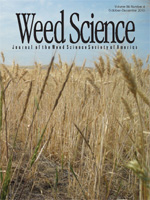Crops that effectively compete with weeds may be more suitable in low-input agricultural systems. A 2-yr field experiment was conducted in northern Greece to assess the competitiveness of seven annual aromatic plants (anise, sweet fennel, sweet basil, dill, coriander, parsley, and lacy phacelia) on common purslane, common lambsquarters, black nightshade, and barnyardgrass. The phytotoxicity of the essential oils produced by these aromatic plants was also determined using a perlite-based bioassay with barnyardgrass. Separation, identification, and quantification of the volatile compounds of these essential oils were also performed. After the harvest of the aromatic plants (8 wk after planting), the greatest weed fresh weight reduction (94 to 100%) was recorded in lacy phacelia, whereas the least (0 to 30%) was recorded in parsley. Lacy phacelia and sweet fennel produced the greatest fresh biomass yield in weedy and weed-free treatments, whereas parsley, dill, and coriander produced the lowest. Biomass of sweet fennel and anise was reduced by only 9 to 11% by weed competition, whereas biomass of lacy phacelia was not significantly affected. The essential oils isolated from sweet fennel and sweet basil were the most phytotoxic on barnyardgrass, whereas those isolated from lacy phacelia and anise were the least phytotoxic. Conclusively, aromatic plants with great competitiveness such as lacy phacelia, anise, and sweet fennel provided great weed suppression and they could be cultivated with low inputs in herbicides. However, high competitiveness of aromatic plants may not always be correlated with high essential oil phytotoxicity.
Nomenclature: Anise, Pimpinella anisum L; barnyardgrass, Echinochloa crus-galli (L.) Beauv. ECHCG; black nightshade, Solanum nigrum L. SOLNI; common lambsquarters, Chenopodium album L. CHEAL; common purslane, Portulaca oleracea L. POROL; coriander, Coriandrum sativum L; dill, Anethum graveolens L; lacy phacelia, Phacelia tanacetifolia Benth; parsley, Petroselinum crispum (P. Mill.) Nyman ex A.W. Hill; sweet basil, Ocimum basilcum L; sweet fennel, Foeniculum vulgare P. Mill.





